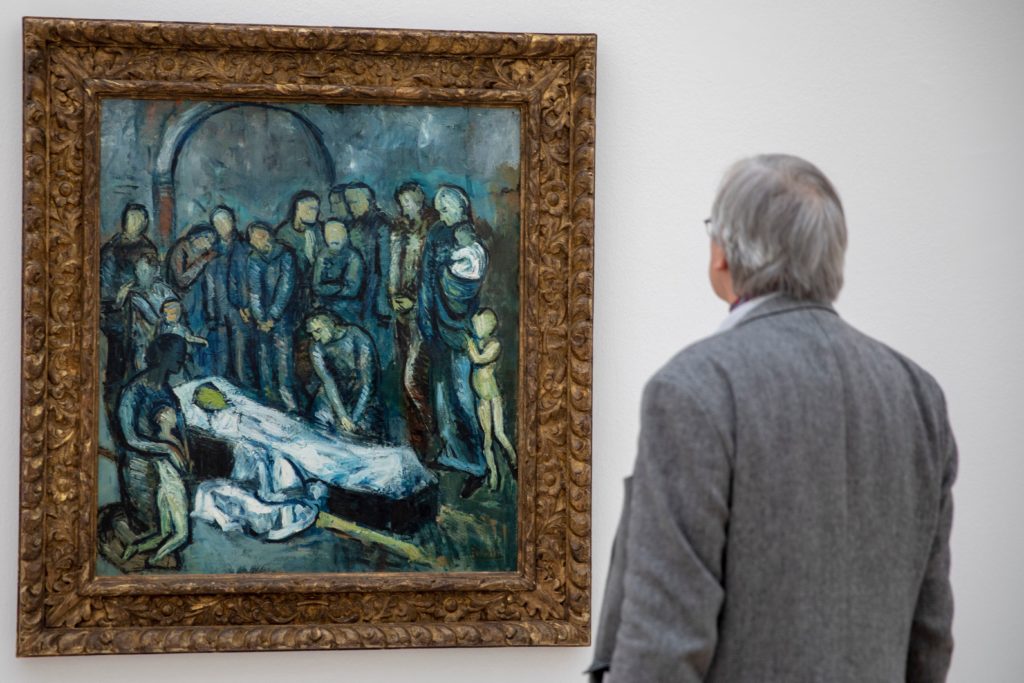[ad_1]

Pablo Picasso, La Mort (La Mise au tombeau), 1901, installation view at Fondation Beyeler, Riehen, Switzerland.
PATRICK STRAUB/EPA-EFE/SHUTTERSTOCK
Two of the biggest museum exhibitions on now are Pablo Picasso blockbusters: one at the Fondation Beyeler in Riehen, Switzerland, focuses on the artist’s Blue and Rose Periods; the other, at the UCCA Center for Contemporary Art in Beijing, is the biggest show ever devoted to his work in China. With these in mind, we here republish sculptor Mary Callery’s personal remembrance of her time with Picasso from the March 1–14, 1942, issue of ARTnews. “It is not an easy task to write about Picasso,” Callery notes. Her essay follows below. —Alex Greenberger
“The Last Time I Saw Picasso”
By Mary Callery
March 1–14, 1942
For the Picasso show now current at the Paul Rosenberg Gallery, ARTnews asked Mrs. Meric Callery, friend of the artist and owner of one of the great Picasso collections, to write a few personal impressions of a painter whose work, in his lifetime and in our eyes, has already assumed a kind of classic rightness.
It is not an easy task to write about Picasso, so much has already been said, and yet I had an especial opportunity of seeing him in an everyday sort of way. The more one saw, the greater he became. I find myself even now often repeating the things I became aware of through him. He was always so generous to aspiring artists. Generous with his enthusiasm and concretely helpful with those French billets de banque. I remember his giving a young Cuban painter a folded bill one day: the lad put it in his pocket, not daring to look at how much it was. When he got down those long, broad steps leading from the atelier of the rue des Grands Augustins he opened it and found a thousand francs—a fortune! In another minute he was bounding up those steps. “Picasso, you have made a mistake, look what you have given me!”
For years Picasso teased me about my work since I did not have the courage to show it to him. I am a sculptress, and each evening as we, his little group, gathered together he would look at me, his intelligent keen eyes twinkling and say, “Well, what have you done today, a seascape?” Then he would become serious and say “Don’t work with a model. What do you need a model for? Don’t you know that a human body has a head, two arms, and two legs? You should do men, for you will understand them better. Men understand women better.”
This writing about him is fun, it is fun to live again those Paris days. Days when life looked beautiful, quivering with the dreams of the mind. It is as though it were yesterday that I spent an afternoon in Picasso’s flat, rue la Boëtie. He took us there after a lunch at that sympathetic yet highly repellent Brasserie Lipp. As he flung open his door and stepped back to let us enter, our eyes were blinded by dust-drenched sunlight. You wondered how it was actually possible to get through all the mail strewn upon the entrance floor. Picasso chuckled with delight. “See how I answered my letters?” I learned afterwards that so great was his order, in this seeming disorder, that if as much as an envelope was moved he was profoundly upset. That day we saw picture after picture and had a peek at a room literally stacked with paintings and drawings. Once actually started, Picasso adores showing his pictures, for each one recalls the emotion he had when painting it. Often he would explain this, always he studied the picture himself to see how it had weathered the years.
Another day we went to his little château at Bois-Geloup fifty kilometers or more to the north of Paris. That was a special day for me for there was his atelier de sculpture. What a revelation! That lovely, small classic château, its court with its old stables and servants’ dwellings. … One of the stables was used for sculpture. It had an ordinary strip of narrow horizontal window and when there was not sufficient light the door would be left open. The door was left open for perspective too. You cannot imagine anything more exciting than standing off in the courtyard and looking into the stable to one of his big tree-like white plaster figures. Often he “seeded” his sculpture in the château park. Sometimes they had an exotic, plant-like quality, such as the monument to Apollinaire. They just grew, without a base or an arranged setting, as though they had sprung from his very earth.
The last time I saw Picasso’s pictures with Picasso was not in the dust-drenched sunlight of either of his studios or the gentle countryside of France; but under the Boulevard des Italiens, in a subterranean world. He had a great corridor to himself, with rooms leading off it, and in those rooms the paintings and drawings were stacked in their familiar order. Again he pulled out undreamed-of treasures. Again his eyes sparkled with amusement in showing something he had carefully hidden from the public eye.
And there in that stricken Paris he still is. … Our thoughts go out to him and worry over him.
[ad_2]
Source link

